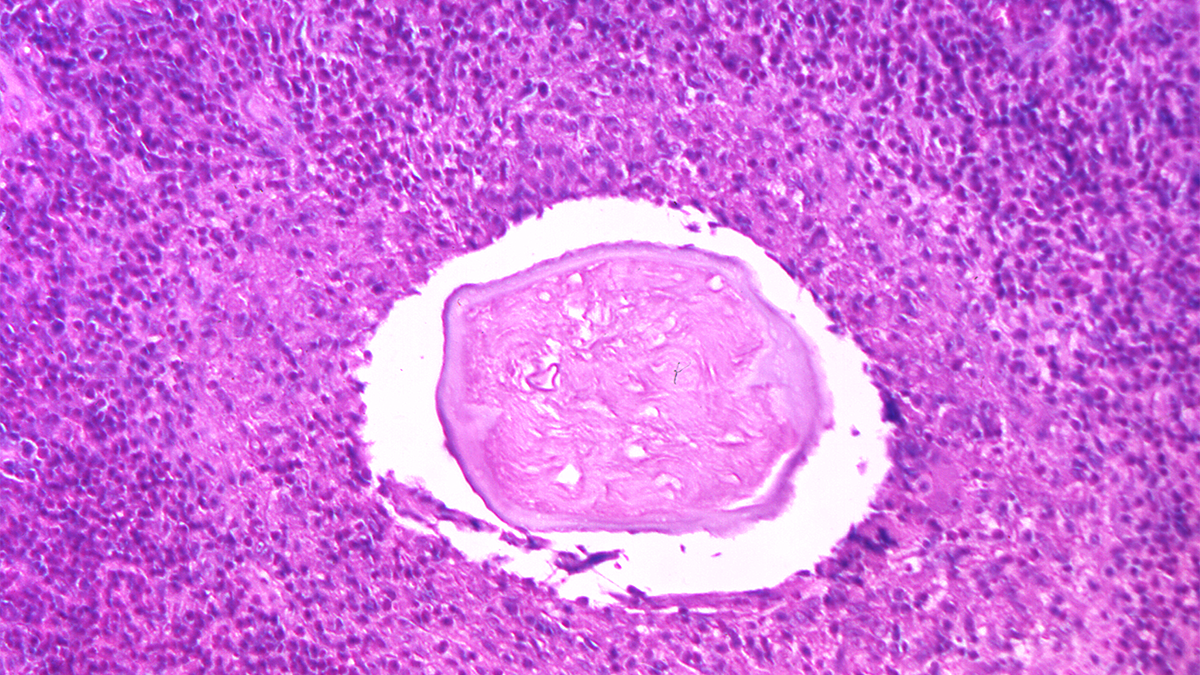Key points
- Dilofilariasis is an infection caused by parasitic roundworms.
- In dogs, it is called heartworm infection.
- Infection is spread by mosquito bites.

Overview
Dirofilaria are long, thin parasitic roundworms that infect a variety of mammals. Infection is transmitted by mosquito bites. There are many species of Dirofilaria, but human infection is caused most commonly by three species, D. immitis, D. repens, and D. tenuis. The main natural hosts for these three species are dogs and wild canids, such as foxes and wolves (D. immitis and D. repens) and raccoons (D. tenuis). D. immitis is also known as "heartworm." D. repens is not found in the United States, and D. tenuis appears to be restricted to raccoons in North America.
Dirofilariasis is the disease caused by Dirofilaria worm infections. In dogs, one form is called "heartworm disease" and is caused by D. immitis. D. immitis adult worms can cause pulmonary artery blockage in dogs, leading to an illness that can include cough, exhaustion upon exercise, fainting, coughing up blood, and severe weight loss.
Symptoms
Human infections with D. immitis can result in areas of inflammation induced by dying adult worms in pulmonary arteries that appear as coin lesions on chest x-rays. Coin lesions can also be caused by cancer and other serious diseases, and a coin lesion discovered accidentally on chest x-ray usually leads to an invasive procedure to learn the cause. Most human cases of pulmonary dirofilariasis are diagnosed from samples taken during these procedures. Most reported cases of D. immitis infection in humans have been in persons with no symptoms. People with symptoms can have cough (including coughing up blood), chest pain, fever, and pleural effusion (excess fluid between the tissues that line the lungs and the chest cavity). Rarely, D. immitis worms have been found in humans at outside the lungs, including the brain, eye, and testicle. When D. repens and D. tenuis infection is reported in humans, it is generally as the cause of nodules under the skin, but on occasion, worms are found in the conjunctiva.
Who is at risk
Dirofilariasis is found throughout the world where Dirofilaria species are common. In the United States, canine dirofilariasis has been reported from all states, and D. tenuis in raccoons is common in many areas where raccoons are found. Canine and human dirofilariasis are most prevalent in eastern and southeastern states, although rates are increasing rapidly in a number of western states. D. immitis is the Dirofilaria species most commonly reported to cause dirofilariasis in humans in the United States. D. repens is the Dirofilaria species most commonly reported to cause dirofilariasis among humans in Europe. One or both of these species have been found to cause human dirofilariasis in other parts of the world.
How it spreads
The definitive mammalian hosts for Dirofilaria are primarily domestic dogs, wild canids (such as wolves and foxes), and raccoons. In these hosts, sexually mature worms produce microfilariae that circulate in the blood and are ingested by mosquitoes during a blood meal. In mosquitoes, the microfilariae develop into larvae that migrate to the proboscis (the long, tubular part of the mouth of the mosquito that punctures the skin during a blood meal), where they are ready to infect another host during a blood meal. Several types of mosquitoes are capable of transmitting Dirofilaria infection, including Aedes, Anopheles, and Mansonia.
Humans and a wide range of other mammals are accidental hosts that play no role in the transmission of Dirofilaria. In these hosts, Dirofilaria larvae can develop into adult worms but the worms remain sexually immature and no microfilariae are produced.
Resource
Prevention
Dirofilariasis can be prevented by avoiding mosquito bites in areas where mosquitoes may be infected with Dirofilaria larvae. The risk of such mosquito bites can be reduced by leaving as little skin exposed as possible, by the use of insect repellent when exposed to mosquitoes, and by sleeping under an insecticide-treated bednet in areas where Dirofilaria-infected mosquitoes bite at night and have access to sleeping areas.
Diagnosis
In humans, dirofilariasis is diagnosed most frequently by the examination of tissue from areas of inflammation in the lung obtained as part of the diagnostic investigation of coin lesions (small, round abnormalities) on chest x-rays or from the examination of tissue in nodules under the skin. Blood tests are not yet helpful in the diagnosis of dirofilariasis in humans.
Treatment
The definitive treatment of Dirofilaria infection in humans is surgical removal of lung granulomas and nodules under the skin; this treatment is also curative. In many cases, no treatment with medicines is necessary.
This information is not meant to be used for self-diagnosis or as a substitute for consultation with a health care provider. If you have any questions about the parasites described above or think that you may have a parasitic infection, consult a health care provider.
